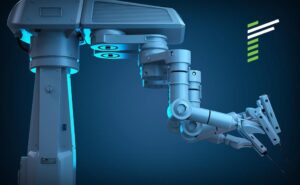Globally, manufacturing is undergoing an enormous change in trade. According to McKinsey (MGI), $4.6 trillion in trade could shift in 5 years1. Unfortunately, manufacturers are still grappling with supply chain disruptions and difficulties sourcing raw materials. Even if they can find what they need, often prices have increased to levels that are threatening margins.
Add to that the significant increases in demand delayed products, plans, and purchases, and the challenges of implementing new technologies into the production process. Finding and retaining enough employees with the skills manufacturers need continues to be a top challenge.
Organisations are scrambling to discover the secret that that will allow them to manage these challenges at the same time — and come out on top. Some of these methods include looking for suppliers geographically closer to production centres, a more resilient supply chain, employees who have the skills needed for Industry 4.0 manufacturing, and technology to help them modernize and bring new efficiency to production.
So it’s no surprise to see supply chains slowly pivoting towards automation, driven by intelligent analytics, big data, and cognitive computing2. Some companies, however, are still working to become paperless, and feel overwhelmed by the undertaking that lies before them. Those that have begun their digital journey might be unsure of how to move forward and need support with the next steps.
What automation brings to manufacturing
There are several reason behind the manufacturing sector’s pivot towards automation:
- Efficiency and productivity
Automation can work continuously without breaks, fatigue, or errors. This results in increased efficiency, productivity, and output. Machines can work faster and more accurately than humans, which leads to reduced production time and cost. - Cost reduction
Automation reduces the cost of labour, materials, and energy. This allows manufacturers to produce goods at a lower cost, which can increase profits, competitiveness, and market share. - Quality control
Automation can improve quality control by minimizing human error and variability. Automated systems can measure and monitor production processes, detect defects, and make adjustments in real-time. This results in higher-quality products and fewer defects or recalls. - Safety
Automation can improve workplace safety by reducing the need for workers to perform hazardous tasks, such as working with heavy machinery, chemicals, or dangerous materials. This can also result in lower insurance and workers’ compensation costs. - Innovation and flexibility
Automation can enable manufacturers to innovate and develop new products by providing greater flexibility and agility in production processes. Automated systems can quickly adapt to changing demands, customer preferences, and market trends.
Not all that automates is gold
While automation offers many benefits to the manufacturing sector, there are also inherent risks that should be taken into consideration.
Acceleration of job losses
Automation is predicted to displace 20 million manufacturing jobs by 20303. Automation can lead to job losses, particularly for workers who perform repetitive and routine tasks. This can have significant impacts on individuals, families, and communities.
The ‘new automation’ of the next few decades—with much more advanced robotics and artificial intelligence (AI)—will widen the range of tasks and jobs that machines can perform, and have the potential to cause much more worker displacement and inequality than older generations of automation4.
Cybersecurity risks
Automated systems are also more vulnerable to cyber-attacks, which can compromise sensitive data, intellectual property, and production processes. Cybersecurity breaches can also result in financial losses, reputational damage, and legal liabilities.
As many workforces have gone digital due to the pandemic, there has been an increase in network attacks and intrusions from cybercriminals. Manufacturing is one of the most targeted industries, with network security provider Morphisec reporting that one in five companies are targeted by cyberattacks5. Hackers are gaining more access to production systems because employees are telecommuting, rather than working on-site.
Erosion of flexibility and agility
Over-reliance on automated systems can lead to a lack of flexibility and agility, particularly when it comes to responding to unexpected or rapidly changing circumstances. In 2017, it was estimated there were 1.9 million industrial robots around the world, up from 1.2 million in 20136.(6) That’s an increase of 37% in just four years.
There is a much bigger price to failure with automation vs a simple MHE-based picking process. As the cost to try an iteration of a new process increases, a team will start to lose their “sandbox” that would allow them to try as many sequential iterations needed to dial a process in. For large investment projects, you pretty much have to get it right on the first shot7.
Striking an automation balance in manufacturing
By taking a balanced approach to automation in manufacturing, companies can achieve the benefits of increased efficiency, productivity, and quality control while also mitigating the potential risks associated with automated systems. Some of the steps can be:
- Evaluating the benefits and risks
Companies should determine whether it’s appropriate for their specific needs. This evaluation should include considerations of cost, productivity, quality control, safety, and cybersecurity risks. - Prioritising flexibility and agility
Companies that keep flexibility and agility at the forefront of their automation strategies will be better equipped to respond to unexpected or rapidly changing circumstances. This may include investing in technologies that can adapt to changing demands, customer preferences, and market trends. - Considering the human element
Companies should consider the potential impact that manufacturing automation can have on workers and the community and capitalise on opportunities to upgrade the knowledge base of their workforce to counter potential disruptions in the horizon. This may include training workers to work alongside automated systems or providing support for displaced workers. - Operational efficiency
AI can be used to optimize hospital operations, such as staffing and scheduling, reducing costs and improving patient outcomes.
Unlock the full potential of your supply chain, powered by data and analytics. With our expertise and knowledge base, we can help you drive better decisions and deliver sustainable results. If you would like to learn more, please feel free to get in touch with us.












